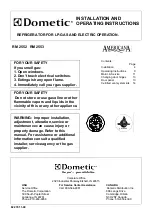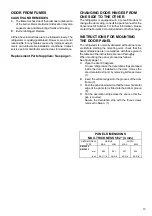
OPERATING INSTRUCTIONS
IMPORTANCE OF LEVELING A
REFRIGERATOR
In an absorption refrigerator system, ammonia is lique-
fied in the finned condenser coil at the top rear of the
refrigerator. The liquid ammonia then flows into the
evaporator (inside the freezer section) and is exposed
to a circulating flow of hydrogen gas, which causes the
ammonia to evaporate, creating a cold condition in the
freezer.
The tubing in the evaporator section is specifically
sloped to provide a continuous movement of liquid am-
monia, flowing downward by gravity through this section.
If the refrigerator is operated when it is not level and the
vehicle is not moving, liquid ammonia will accumulate in
sections of the evaporator tubing. This will slow the
circulation of hydrogen and ammonia gas, or in severe
cases, completely block it, resulting in a loss of cooling.
Any time the vehicle is parked for several hours with the
refrigerator operating, the vehicle should be leveled to
prevent this loss of cooling. The vehicle needs to be
leveled only so it is comfortable to live in (no noticeable
sloping of floor or walls).
When the vehicle is moving, the leveling is not critical,
as the rolling and pitching movement of the vehicle will
pass to either side of level, keeping the liquid ammonia
from accumulating in the evaporator tubing.
GAS OPERATION
Before starting the refrigerator, check that all the manual
gas valves are in the ON position. DO NOT forget the
manual shutoff valve on the rear of the refrigerator, see
FIG. 1.
1.
To start the refrigerator, turn knob A to the "GAS"
position.
2.
Turn the thermostat knob B to position 4.
3.
Press the button C to stop and keep it depressed.
When the gas is lit at the burner the RED indicator D
is on the GREEN field, (ON).
4.
If the RED indicator D is not on the GREEN field,
repeat the procedure. If flame blows out, the reigniter
will automatically relight the burner.
5.
To shut off the refrigerator turn the knob A to
"OFF" position.
NOTE: After changing an LP tank, or after a long shut
off period, the gas line is likely to be filled with air. You
may have to repeat the lighting procedure several times
to purge the air out of the gas lines.
As soon as the necessary cold temperature inside the
cabinet has been reached, adjust the thermostat knob
to required setting.
WARNING
Most LP gas appliances used in recreational ve-
hicles are vented to the outside of the vehicle.
When parked close to a gasoline pump, it is
possible that the gasoline fumes could enter
this type of appliance and ignite from the
burner flame, CAUSING A FIRE OR AN EXPLO-
SION.
FOR YOUR SAFETY, it is recommended that all
LP gas appliances which are vented to the out-
side should be shut off when refueling.
ELECTRIC OPERATION
1.
Check to be sure the power cord is properly connec-
ted to the power supply. See FIG. 11). If the refrige-
rator is equipped for 12 volt DC operation, the tow
vehicle or caravan engine should be running to pre-
vent discharging the battery.
2.
Turn the knob A to the position marked "AC" for 120
volt AC operation or "DC" for 12 volt DC operation.
3.
Turn the thermostat knob B to position 4.
4.
To shut off the refrigerator turn the knob A to
"OFF" position.
THERMOSTAT
The refrigerator is equipped with a thermostat that can
be adjusted by turning the knob B to different setting to
maintain the desired cabinet temperature.
At OFF In gas operation, the thermostat closes its
main valve and the burner runs continuously
at the bypass rate, just enough to keep the
burner lit. In electrical operation, the contacts
in the thermostat are open and the heating
elements are off.
At MAX In gas operation, the thermostat allows the
burner to remain on high flame continuously.
In electric operation, the heating element is
"ON" continuously. Lowest cabinet and freez-
er temperatures are obtained at this setting.
The thermostat can be adjusted between "MAX" and
"OFF" to obtain the desired cabinet temperature.
The closer the knob is to "MAX" - the colder the cabinet
temperature. The closer the knob is to "OFF" - the
warmer the cabinet temperature.
When the thermostat reaches the set temperature, it will
cut the burner back to bypass or, in electric operation,
shut off the heating element.
The setting of the thermostat is not critical, but we
recommend it be adjust to maintain a dry frost on the
cooling fins. Adjust the thermostat knob closer to "MAX"
when the outside temperature becomes warm.
A
B
C
D
9


































